Location and Access
![]() These notes relate to one of 4 way-marked trails in the vicinity of the village of Barr (NX 275 940) in the hills ESE of Girvan. Information on the trails, including maps,can be had from www.ayrshirepaths.org.uk or from a free leaflet available from the dispenser at the forest car park which is the official starting point or from tourist offices or public libraries. The notes draw freely on the published leaflet and full acknowledgement is due to its authors.
These notes relate to one of 4 way-marked trails in the vicinity of the village of Barr (NX 275 940) in the hills ESE of Girvan. Information on the trails, including maps,can be had from www.ayrshirepaths.org.uk or from a free leaflet available from the dispenser at the forest car park which is the official starting point or from tourist offices or public libraries. The notes draw freely on the published leaflet and full acknowledgement is due to its authors.
Ayrshire Paths is an initiative supported by various organisations including Scottish Enterprise Ayrshire, Scottish Natural Heritage and the three Ayrshire Councils. They have signposted and improved many traditional walks and pathways around Ayrshire and have a continuing programme of development.
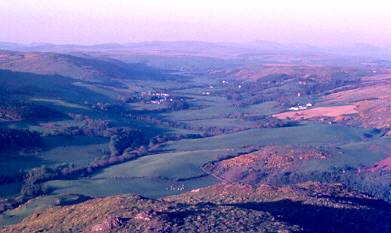
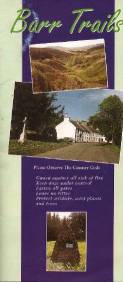 Nearly 5km of paths have been joined together to form circular routes by riverside, forest and open hill, very typical of southern, inland Ayrshire. Access is thanks to the goodwill and generosity of the landowners: Forest Enterprise and W A F Cuninghame. Of the 4 way marked routes, The Devil’s Trail, coded purple and some 6.5 km long has the greatest diversity of habitat for birds. To reach the start, turn inland from the coastal A77 just north of Girvan and follow B734 up into the hills to Barr. The road winds over typical grass and moorland, good birding for the passengers, but the driver will need concentration. In Barr, where B734 goes sharp left at the Inn, continue straight on along a rough single track road for 1 km, then left at a fork to the forest car park and official start of the trails.
Nearly 5km of paths have been joined together to form circular routes by riverside, forest and open hill, very typical of southern, inland Ayrshire. Access is thanks to the goodwill and generosity of the landowners: Forest Enterprise and W A F Cuninghame. Of the 4 way marked routes, The Devil’s Trail, coded purple and some 6.5 km long has the greatest diversity of habitat for birds. To reach the start, turn inland from the coastal A77 just north of Girvan and follow B734 up into the hills to Barr. The road winds over typical grass and moorland, good birding for the passengers, but the driver will need concentration. In Barr, where B734 goes sharp left at the Inn, continue straight on along a rough single track road for 1 km, then left at a fork to the forest car park and official start of the trails.
Since, however, Barr is a beautiful village, and the 1km track is itself excellent birding along the wooded banks of a sparkling, clear burn, there is much to be said for parking in Barr and proceeding on foot.
![]() Might be accessible in part, further details to be posted on the website in due course.
Might be accessible in part, further details to be posted on the website in due course.
![]() A network of suitable routes converge on Barr, including a forest route from National Cycle Route 7.
A network of suitable routes converge on Barr, including a forest route from National Cycle Route 7.
The Devil’s Trail
The walk begins along a forest road beside the Water of Gregg, passing through or beside well-established deciduous and coniferous woodland and open scrubland. As the track winds through the glen, views of open hillside and recently planted moorland emerge. Look out for the glade with bat-boxes. After some 2km, the trail leaves the forest road, and climbs steeply through mature conifers to a highest point with breathtaking views across the Stinchar Valley to the hills beyond. It then plunges down a gully and across the Changue Burn to reach the far hillside at High Changue from where it returns by a forest road with deciduous and coniferous woodland to the north and open views over farm, forest and moor to the south.
The Birds
Almost anything in the way of inland birds is possible since all habitats are represented. The following is a sample from my own experience. In season, Spotted Flycatcher abound along the access road as do Coal, Blue, Great and Long-tailed Tit all year. The squeak of Goldcrest is ever present. Willow Warbler, Chiffchaff, Blackcap and Garden Warbler are common in summer and I have heard Wood Warbler on occasion but not yet Grasshopper Warbler, though the terrain seems suitable and they are certainly present in the vicinity. Treecreeper breed in numbers and I have heard Great Spotted Woodpecker but not Green Woodpecker. The ubiquitous Chaffinch are there in numbers as are Linnet, Siskin, Goldfinch and Greenfinch and the occasional pair of Bullfinch. On the highest part of the trail I have had several excellent close sightings of Crossbill. House Sparrow is still to be seen but not a single Tree Sparrow so far. Dunnock, Robin and Wren, of course, are around in numbers, and Stonechat but not yet Whinchat or Wheatear, though some of the other trails which take to the moors should yield them. On the far hillside, by the farm, a Redstart held territory one year. Meadow Pipit are common; I must look out for Tree Pipit. Both Pied and Grey Wagtail inhabit the glen. I have never seen a Dipper, which is a curious omission. All three common thrushes breed here. In spring and autumn many hundreds of Redwing and Fieldfare have been seen passing through. Several pairs of Buzzard have territories along the walk, and Kestrel have been seen quite often; Peregrine on one occasion; Sparrowhawk and Merlin not yet – I keep looking, the habitat is right. The open moor and young plantation zones should suit Hen Harrier and Short-eared Owl. I have heard the atmospheric deep croak of Raven as a pair passed over the glen.
Further Information
The other walks extend the range of habitat to include cleared forest and extensive open moorland. The approach roads to Barr pass through stock and arable farmland and over open moorland and young plantations. There is ample scope to stop and look. Since the whole area is close to the coast by Turnberry and Girvan, a combined coastal and inland birding trip is easy to organise – and an attractive Ayrshire village stop makes a pleasing objective for all the family for the day.
Caution
The locally researched leaflet contains this story:
Legend has it that near High Changue, there is the site of a famous battle between the Laird of Changue and the Devil. The story goes that Changue was getting short of money and he decided to make a bargain with the Devil. He would sell his soul in return for great wealth.
The Laird’s fortunes changed and he prospered for many years. When the time came to deliver his soul the Laird reneged on his bargain and refused to go. The devil proceeded to lay hold of him, but Changue, placing his Bible on the turf and drawing a circle with his sword around him, sturdily and, as it turned out, successfully defied his opponent.
The story must be true because to this day, on the hill above High Changue you can see the Devil’s footprints, the circle drawn by the sword and the mark of the Bible clearly visible on the grass.
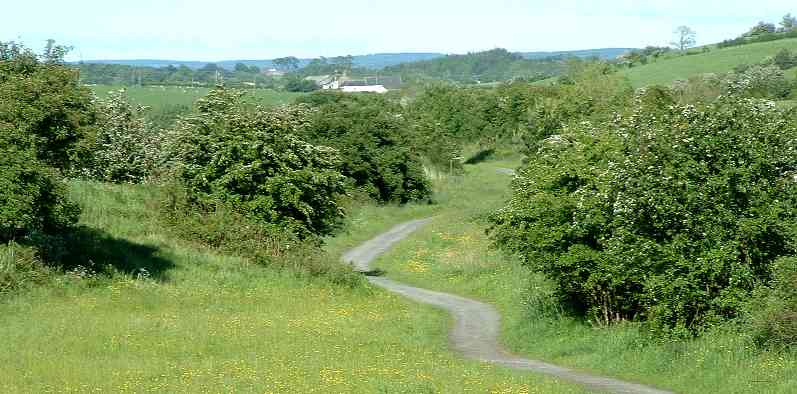 Access the line from the north side of Knockentiber village on the B751 at OS grid reference NS 400 96 or the unclassified road to Kilmarnock at NS 404 95. Access at the north end of Springside on Overton Road (to Warwickdale) at NS 69 91 or via the farm track (which crosses a stubble field in winter) at NS 69 93 which will direct you onto the line approximately 0.5 km east of the village. While it is a 4 km walk from end to end, the areas of greatest interest are actually around the villages. Park in either village and walk the path in either direction. It is an ideal site to cover by bicycle. Alternatively, an unclassified road from Knockentiber to the Cunninghamhead area crosses the line approximately half way where there is space for roadside parking on the left after the bridge.
Access the line from the north side of Knockentiber village on the B751 at OS grid reference NS 400 96 or the unclassified road to Kilmarnock at NS 404 95. Access at the north end of Springside on Overton Road (to Warwickdale) at NS 69 91 or via the farm track (which crosses a stubble field in winter) at NS 69 93 which will direct you onto the line approximately 0.5 km east of the village. While it is a 4 km walk from end to end, the areas of greatest interest are actually around the villages. Park in either village and walk the path in either direction. It is an ideal site to cover by bicycle. Alternatively, an unclassified road from Knockentiber to the Cunninghamhead area crosses the line approximately half way where there is space for roadside parking on the left after the bridge.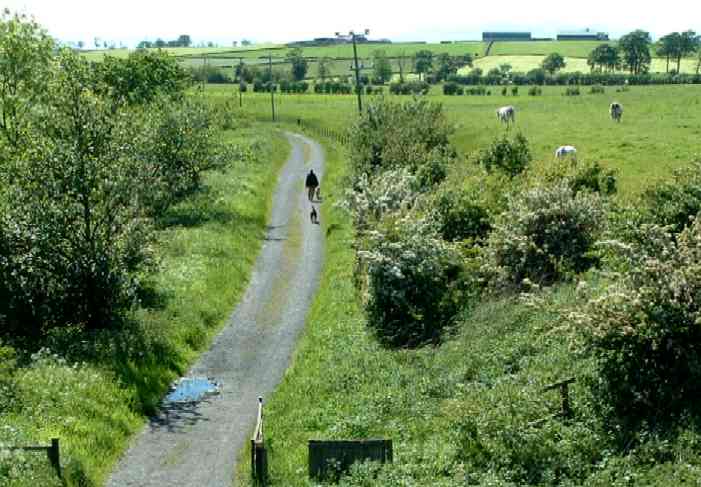 The disused railway line is a rich, semi-natural, linear habitat of overgrown hedgerow, scrub and rough grassland verges traversing some fairly interesting farmland. The land is drained by the Garrier and Woodhill Burns. Smaller areas include a juncus rush marsh, bramble-strewn wasteland, nettle beds, bricks and mortar and a marshy cutting on the line (before recently introduced drainage). However, recent tarmac “improvements” at the Knockentiber end have damaged much of the habitat, although hopefully within time the area will recover. Fly-tipping, burnt-out cars and illegal shooting are all a problem here from time to time.
The disused railway line is a rich, semi-natural, linear habitat of overgrown hedgerow, scrub and rough grassland verges traversing some fairly interesting farmland. The land is drained by the Garrier and Woodhill Burns. Smaller areas include a juncus rush marsh, bramble-strewn wasteland, nettle beds, bricks and mortar and a marshy cutting on the line (before recently introduced drainage). However, recent tarmac “improvements” at the Knockentiber end have damaged much of the habitat, although hopefully within time the area will recover. Fly-tipping, burnt-out cars and illegal shooting are all a problem here from time to time.
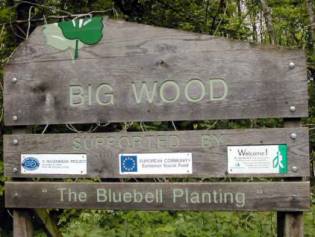 The aptly named Big Wood (NS 515 75), known locally as “The Bluebell Planting” is about 24 km from Ayr just east of Galston on the A71 next to Loudoun Golf Course. The wood is privately owned, but is managed by East Ayrshire Woodlands who have a 25 year management agreement allowing public access. Parking is available in the lay-by at Hags Bridge (NS 517 71) off the A71. A well defined track (which is also a public Right Of Way) starts just beside the lay-by and runs up through the site to Woodhead Farm. Walking up the track gives excellent views of the varied habitat and of some of the magnificent specimen trees in the wood, there is also plenty of scope to do a little exploring off the beaten track, but please observe any “private property” signs you come across.
The aptly named Big Wood (NS 515 75), known locally as “The Bluebell Planting” is about 24 km from Ayr just east of Galston on the A71 next to Loudoun Golf Course. The wood is privately owned, but is managed by East Ayrshire Woodlands who have a 25 year management agreement allowing public access. Parking is available in the lay-by at Hags Bridge (NS 517 71) off the A71. A well defined track (which is also a public Right Of Way) starts just beside the lay-by and runs up through the site to Woodhead Farm. Walking up the track gives excellent views of the varied habitat and of some of the magnificent specimen trees in the wood, there is also plenty of scope to do a little exploring off the beaten track, but please observe any “private property” signs you come across.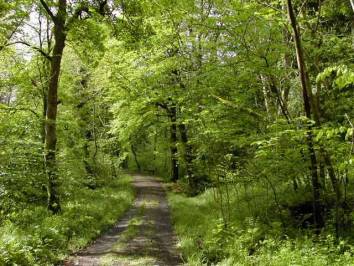 Big Wood is the site of an ancient woodland which has been extensively managed in the past. As part of Loudoun Castle Estate the woods were replanted in the late 19th and early 20th Century as a designed landscape, this accounts for many of the mature specimen trees which are in the woods today. The woods are largely comprised of Oak, Beech, Elm and Ash with a good under-storey of Hazel, Elder, Rowan and Holly. In spring the wood is carpeted with Bluebells, making this a particularly attractive time to visit, there is also a great variety of plants and wildflowers to be found right through the summer.
Big Wood is the site of an ancient woodland which has been extensively managed in the past. As part of Loudoun Castle Estate the woods were replanted in the late 19th and early 20th Century as a designed landscape, this accounts for many of the mature specimen trees which are in the woods today. The woods are largely comprised of Oak, Beech, Elm and Ash with a good under-storey of Hazel, Elder, Rowan and Holly. In spring the wood is carpeted with Bluebells, making this a particularly attractive time to visit, there is also a great variety of plants and wildflowers to be found right through the summer.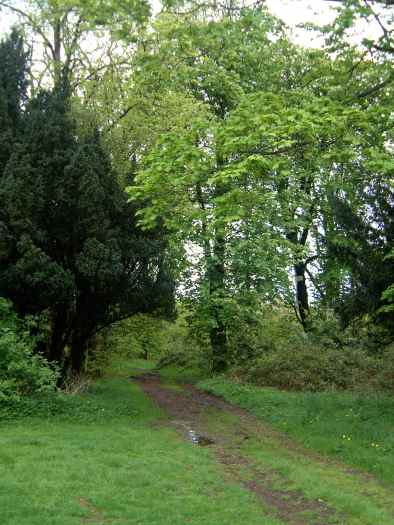
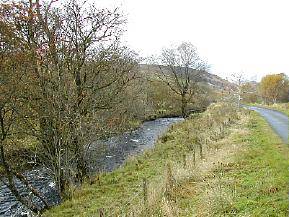 A small car park at the entrance to Straiton from the Ayr side provides a pleasant picnic site beside the River Girvan and is the start of a number of local waymarked walks on which information is available in leaflets from tourist offices and dispensers or from Ayrshire Path’s web site. The village has toilets, a cafe and inn. The recommended birdwatching locations include one of these walks, though any of the others could also be rewarding. The other locations are further up into the hills along the Straiton-Newton Stewart road.
A small car park at the entrance to Straiton from the Ayr side provides a pleasant picnic site beside the River Girvan and is the start of a number of local waymarked walks on which information is available in leaflets from tourist offices and dispensers or from Ayrshire Path’s web site. The village has toilets, a cafe and inn. The recommended birdwatching locations include one of these walks, though any of the others could also be rewarding. The other locations are further up into the hills along the Straiton-Newton Stewart road.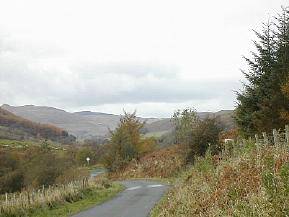
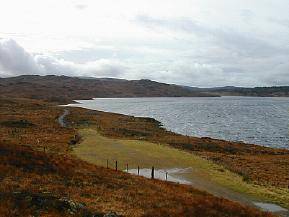
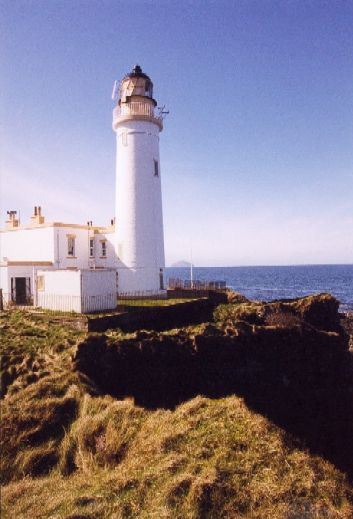
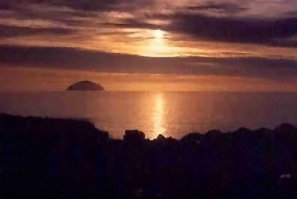 The Course is of world class and has been host to international competitions. It is managed with sympathy for wildlife. A recently formed pool on the inland side of the coast road is worth scanning for ducks and waders.
The Course is of world class and has been host to international competitions. It is managed with sympathy for wildlife. A recently formed pool on the inland side of the coast road is worth scanning for ducks and waders.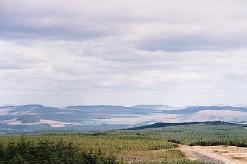 The Cornish Hill Walk is the more interesting ornithologically of the two and as a walk. Though only 5km long, it entails a climb of 100m, quite steep and rough in places. Strong footwear is advisable.
The Cornish Hill Walk is the more interesting ornithologically of the two and as a walk. Though only 5km long, it entails a climb of 100m, quite steep and rough in places. Strong footwear is advisable.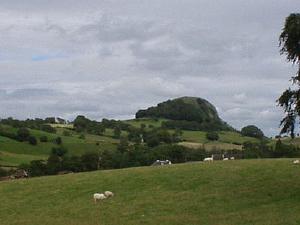
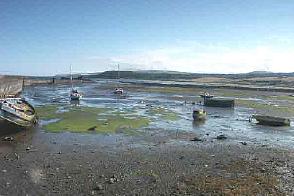
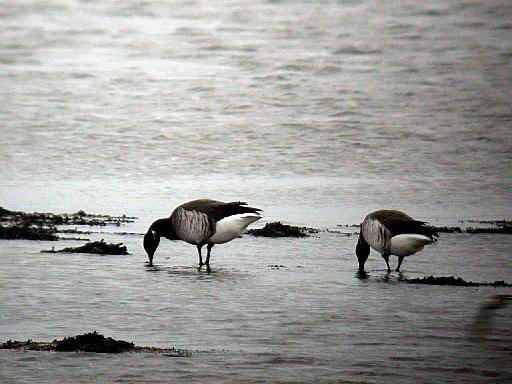
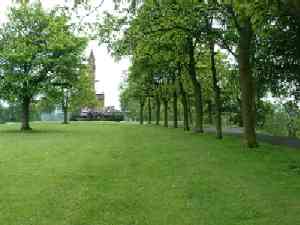
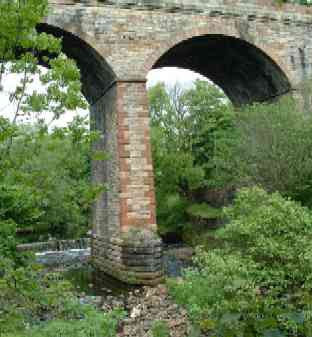 The Kay Park supports breeding Dipper, Grey Wagtail and Spotted Flycatcher among the typical parkland species. The best viewpoint of the river is by the weir at the viaduct on the park side, however, much of the town side of the river provides the best visibility. Bullfinch can often be found in the bushes by the tennis courts (NS 432 82) and Siskin in the alders by the viaduct. In recent years the pond (NS 435 83) has become more interesting (perhaps due to the lack of boating activity) with breeding Coot, Moorhen and Mute Swan. Grey Heron and Cormorant are often present, particularly in winter. The recent autumn and winter (2001/2002) saw, surprisingly, up to a dozen Goosander at times and were probably part of the daily movements of birds between the River Irvine and North Craig Reservoir. Additionally, nesting Herring and Lesser Black-backed Gulls can be observed on the roofs of Kilmarnock College buildings.
The Kay Park supports breeding Dipper, Grey Wagtail and Spotted Flycatcher among the typical parkland species. The best viewpoint of the river is by the weir at the viaduct on the park side, however, much of the town side of the river provides the best visibility. Bullfinch can often be found in the bushes by the tennis courts (NS 432 82) and Siskin in the alders by the viaduct. In recent years the pond (NS 435 83) has become more interesting (perhaps due to the lack of boating activity) with breeding Coot, Moorhen and Mute Swan. Grey Heron and Cormorant are often present, particularly in winter. The recent autumn and winter (2001/2002) saw, surprisingly, up to a dozen Goosander at times and were probably part of the daily movements of birds between the River Irvine and North Craig Reservoir. Additionally, nesting Herring and Lesser Black-backed Gulls can be observed on the roofs of Kilmarnock College buildings.